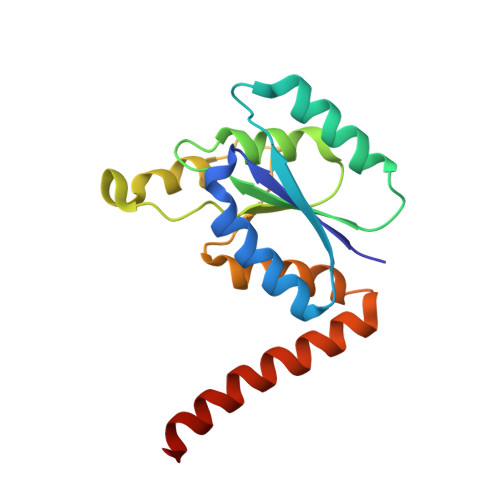Treponema denticola PurE Is a Bacterial AIR Carboxylase.
Tranchimand, S., Starks, C.M., Mathews, I.I., Hockings, S.C., Kappock, T.J.(2011) Biochemistry 50: 4623-4637
- PubMed: 21548610
- DOI: https://doi.org/10.1021/bi102033a
- Primary Citation of Related Structures:
3RG8, 3RGG - PubMed Abstract:
De novo purine biosynthesis proceeds by two divergent paths. In bacteria, yeasts, and plants, 5-aminoimidazole ribonucleotide (AIR) is converted to 4-carboxy-AIR (CAIR) by two enzymes: N(5)-carboxy-AIR (N(5)-CAIR) synthetase (PurK) and N(5)-CAIR mutase (class I PurE). In animals, the conversion of AIR to CAIR requires a single enzyme, AIR carboxylase (class II PurE). The CAIR carboxylate derives from bicarbonate or CO(2), respectively. Class I PurE is a promising antimicrobial target. Class I and class II PurEs are mechanistically related but bind different substrates. The spirochete dental pathogen Treponema denticola lacks a purK gene and contains a class II purE gene, the hallmarks of CO(2)-dependent CAIR synthesis. We demonstrate that T. denticola PurE (TdPurE) is AIR carboxylase, the first example of a prokaryotic class II PurE. Steady-state and pre-steady-state experiments show that TdPurE binds AIR and CO(2) but not N(5)-CAIR. Crystal structures of TdPurE alone and in complex with AIR show a conformational change in the key active site His40 residue that is not observed for class I PurEs. A contact between the AIR phosphate and a differentially conserved residue (TdPurE Lys41) enforces different AIR conformations in each PurE class. As a consequence, the TdPurE·AIR complex contains a portal that appears to allow the CO(2) substrate to enter the active site. In the human pathogen T. denticola, purine biosynthesis should depend on available CO(2) levels. Because spirochetes lack carbonic anhydrase, the corresponding reduction in bicarbonate demand may confer a selective advantage.
Organizational Affiliation:
Department of Biochemistry, Purdue University, West Lafayette, IN 47907-2063, USA.















